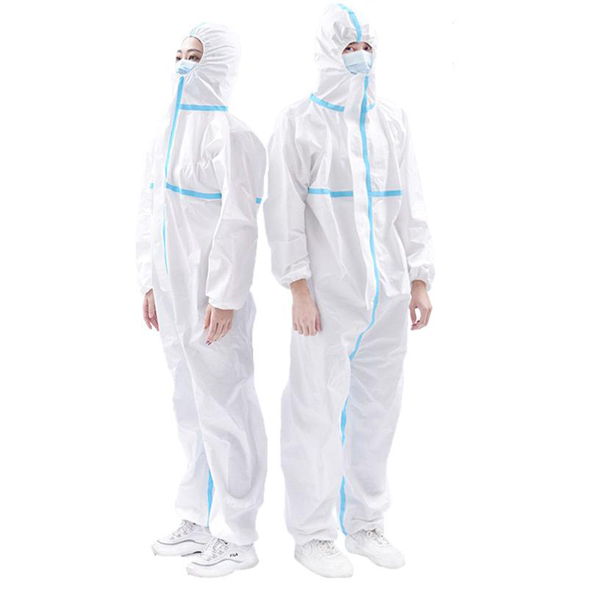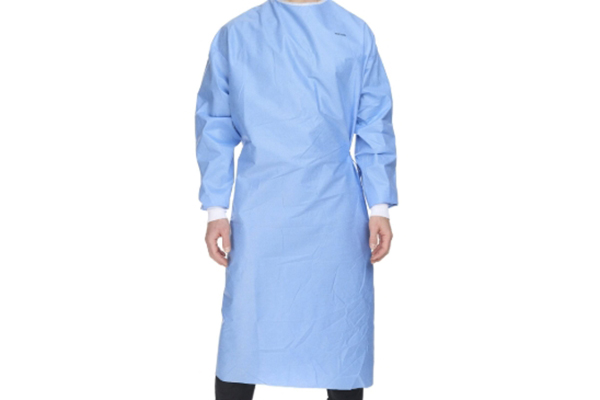The global COVID-19 pandemic threw the critical importance of Personal Protective Equipment (PPE) into the spotlight. As a manufacturer of medical consumables in China, I, Allen, had a front-row seat to the unprecedented surge in demand and the subsequent supply chain chaos. For procurement managers like Mark Thompson in the USA, who are responsible for keeping healthcare facilities stocked, the ppe shortages were a nightmare. The humble isolation gown, a cornerstone of infection control, suddenly became a scarce and precious resource. This crisis forced a crucial conversation in the industry: should we rely on disposable isolation gowns, or is it time to seriously invest in reusable isolation gowns? This article will dive deep into this debate, exploring the pros and cons of each option, the standards that govern them, and how to make the best decision for your facility’s safety, budget, and resilience.
What is an Isolation Gown and What is its Role in Infection Control?
An isolation gown is a piece of personal protective equipment (PPE) used in healthcare settings to protect the wearer from the spread of infection or illness. Its fundamental job is to create a barrier, preventing the transfer of microorganisms and body fluids. When a healthcare worker is treating a patient with a known or suspected infectious disease, the gowns provide a crucial shield, protecting their arms and exposed body areas from contact with potentially infectious materials. This is a fundamental principle taught by organizations like the Association for Professionals in Infection Control and Epidemiology.
These gowns are not just for protecting the healthcare worker. They also play a vital role in preventing the spread of contaminants from the healthcare worker to other patients. Proper gown use, including correct donning and doffing procedures, is essential to break the chain of infection. The isolation gown is a key component of a broader infection control strategy that includes gloves, masks, and eye protection. Whether it’s a disposable or reusable model, the primary function remains the same: to provide reliable barrier protection in various patient care situations.
Disposable Gowns: The Gold Standard of Convenience?
Disposable isolation gowns have long been the standard in many healthcare facilities. As a manufacturer, we produce millions of these single-use garments. They are typically made from lightweight, non-woven synthetic materials that are fluid-resistant. The biggest advantage of disposable gowns is their convenience. There’s no need to launder or track them. A healthcare worker wears one for a single patient interaction and then discards it, eliminating any risk of cross-contamination from improper cleaning. This guarantees a fresh, sterile (if required) barrier for every use.
This convenience was a major reason for their widespread adoption. It simplifies inventory management and removes the entire logistical burden of a laundry service. For busy hospitals and clinics, this is a significant operational benefit. Furthermore, the quality and barrier properties of a disposable gown are consistent and reliable right out of the package. There is no concern about degradation over time from repeated wash cycles. Our factory produces a wide range of high-quality disposable isolation gowns that meet stringent international standards, providing that peace of mind.

The Rise of the Reusable Gown: A Sustainable and Cost-Effective Alternative?
The conversation around the reusable gown has gained significant traction, especially after the pandemic exposed the fragility of the global supply chain. A reusable isolation gown is designed to be used multiple times. It’s typically made from durable, tightly woven fabrics like polyester or cotton-polyester blends that can withstand the rigors of industrial laundering and sterilization. These fabrics can be safely laundered and reused, sometimes up to 75 or 100 times, without losing their protective qualities.
The two most compelling arguments for the reusable gown are cost and sustainability. While the upfront purchase price is higher compared to disposable gowns, they become incredibly cost-effective in the long run. A single reusable gown can replace dozens of disposable gowns, significantly lowering the cost-per-use. From an environmental perspective, they dramatically reduce waste. Hospitals generate enormous amounts of medical waste, and switching to reusable isolation gowns can make a substantial positive impact. The sustainability of reusable options is a growing priority for many healthcare organizations.
Understanding AAMI Levels: What Level of Protection Do You Really Need?
Not all isolation situations are the same, and neither are isolation gowns. The Association for the Advancement of Medical Instrumentation (AAMI) has established a classification system (AAMI PB70) that defines the level of protection a medical gown provides. This is one of the most critical factors a procurement manager needs to understand. Using a gown with inadequate protection can lead to exposure to infectious agents, while over-specifying a gown wastes money.
The AAMI standards outline four levels of barrier protection:
| AAMI Level | Level of Protection | Typical Use Case | Test Requirements |
|---|---|---|---|
| Level 1 | Minimal fluid resistance | Basic care, standard isolation, visitor cover gown in a standard medical unit. | A single water spray test. |
| Level 2 | Low fluid resistance | Drawing blood, suturing, ICU, pathology labs. | Resists water spray and hydrostatic pressure. |
| Level 3 | Moderate fluid resistance | Arterial blood draw, inserting an IV, ER, trauma cases. | Resists higher hydrostatic pressure. |
| Level 4 | Highest fluid resistance (impervious) | Long, fluid-intense surgical procedures, when pathogen resistance is needed, or when non-airborne infectious diseases are suspected. | Resists penetration by blood and viral simulants under pressure. |
Both disposable and reusable gowns are available at all four AAMI levels. It is crucial for healthcare facilities to conduct a risk assessment to determine the appropriate level of protection from potentially infectious materials needed for different tasks and departments. Meeting AAMI PB70 is a key quality indicator.
The Big Question: How Do You Properly Launder and Sterilize a Reusable Gown?
The primary hurdle for adopting a reusable gown program is the laundry. A reusable gown is only effective if it is properly cleaned and decontaminated after every use. Gowns must be laundered according to specific guidelines, often set by bodies like the CDC, to ensure they are safe for reuse. This process requires an industrial laundry facility, either in-house or outsourced, that can handle potentially contaminated linens.
The process of sterilizing reusable gowns involves more than just a hot wash. It includes specific detergents, water temperatures, and drying methods designed to kill pathogens without degrading the gown’s fabric or its barrier properties. The facility must have strict quality control to track the number of wash cycles for each reusable gown, as they must be retired from service after reaching their manufacturer-specified limit. This process also consumes energy and water, though studies have shown the overall environmental footprint can still be lower than that of disposable gowns. The logistical challenge of ensuring every reusable gown is safely laundered is the most significant factor for care facilities to consider.
Disposable vs. Reusable Gown: A Head-to-Head Comparison
So, when it comes down to it, which one is better? The truth is, there’s no single right answer. The best choice depends on a facility’s specific needs, resources, and priorities. Let’s compare them directly on a few key points.
- Protection: Both reusable and disposable gowns can offer equivalent AAMI-rated barrier protection. The key with a reusable gown is maintaining barrier integrity through proper laundering. A disposable gown’s protection is guaranteed out of the package.
- Cost: Disposable gowns have a very low upfront cost but can become expensive over time with high-volume use. Reusable gowns may have a higher initial investment (for the gowns and potentially laundry equipment) but are more cost-effective per use in the long run.
- Convenience: Disposable gowns are the clear winner here. There is no need to collect, transport, launder, or inspect them. This simplifies workflow for healthcare personnel.
- Environmental Impact: The reusable isolation gown is far superior in this category. It drastically reduces solid waste and can lower overall water consumption and energy use compared to the manufacturing process of continuous single-use products.
- Comfort & Feel: This is subjective. Some users prefer the feel of the fabric on a reusable gown, which can offer better breathability. Many modern disposable gowns, however, are designed to be soft and breathable, with features like a comfortable knit cuff for a secure fit.

How Did the COVID-19 Pandemic Change the Conversation Around Gown Use?
The COVID-19 pandemic was a stress test for the global medical supply chain, and in many ways, it failed. The world saw unprecedented ppe shortages. Hospitals in the wealthiest nations were forced to implement a series of strategies or options for conservation, including asking staff to reuse items that were designed to be single-use, a practice that could increase the risk of infection. This crisis fundamentally shifted the perspective on PPE reliance.
The extreme vulnerability exposed by relying solely on a long-distance supply chain for disposable gowns made facilities reconsider local, more resilient solutions. The reusable gown emerged as a powerful option. A hospital with a stockpile of reusable gowns and a reliable laundry service is far less vulnerable to global supply disruptions. The pandemic demonstrated that a robust PPE strategy is not just about cost-per-item; it’s about ensuring a continuous and reliable supply to protect healthcare workers and maintain patient safety during a crisis. The isolation gown market is now more balanced, with a much greater appreciation for the role reusable medical gowns provide.
Key Considerations for Procurement Managers When Sourcing Isolation Gowns
For my clients, the decision to purchase isolation and surgical gowns comes down to a few key factors. First, conduct a thorough needs assessment. Which departments have the highest gown use? What AAMI levels of protection are required for various tasks, from routine patient care to procedures with a high risk of contact with blood and bodily fluids? This data will guide your purchasing strategy.
Second, evaluate your infrastructure. Do you have access to a medical-grade laundry service that can process a reusable gown program? If not, the high upfront investment and logistical setup may make disposable gowns the more practical choice. Third, analyze the total cost of ownership. Don’t just look at the per-piece price. For reusable gowns, factor in the cost to launder and the expected lifespan. For disposable gowns, calculate the annual cost based on consumption rates. Finally, vet your suppliers thoroughly. Whether you’re buying disposable or reusable gowns, ensure the manufacturer complies with all regulatory standards and can provide transparent documentation and a reliable production schedule. Partnering with a trusted supplier of protective clothing and other essentials like medical face masks is paramount.

Can a Hybrid Approach Be the Best Product Solution?
For many healthcare settings, the optimal strategy isn’t choosing one type over the other but implementing a hybrid model. This approach offers the best of both worlds, providing flexibility and resilience. In this model, a facility might maintain a robust inventory of reusable gowns for daily, high-volume use in standard isolation situations. This helps control long-term costs and reduces the facility’s environmental footprint.
Alongside the reusable inventory, the facility would also stock a strategic reserve of disposable gowns. These can be used in situations where a higher level of barrier protection is needed than the standard reusable gown provides, for departments with lower usage where a full reusable system isn’t practical, or most importantly, as a backup during a surge in demand or a disruption to laundry services. This balanced inventory approach creates a multi-layered defense against ppe shortages and supply chain issues. These types of pragmatic product solutions are what will define post-pandemic preparedness.
Building a Resilient PPE Strategy for the Future
The lessons from the COVID-19 pandemic are clear: we cannot afford to be caught unprepared again. Building a resilient PPE strategy requires a shift in thinking from pure cost-cutting to a more holistic view that includes supply security, sustainability, and patient care quality. The debate over reusable vs. disposable isolation gowns is at the heart of this shift. Both gowns make valuable contributions to infection control, and both have a place in modern healthcare.
As a manufacturer, my role is to provide high-quality product solutions, whether that is a box of dependable disposable gowns or other critical apparel like disposable bouffant caps. For procurement managers and clinic administrators, the task is to analyze your unique circumstances and build a smart, flexible inventory that can weather any storm. By understanding the strengths of both disposable and reusable gowns, you can protect your staff, your patients, and your facility from the next public health crisis.
Key Takeaways
- Primary Function: An isolation gown is a critical PPE item that creates a barrier to protect against the transfer of microorganisms and bodily fluids.
- Disposable Gown Pros: They offer ultimate convenience, guaranteed barrier integrity out of the package, and no laundry logistics.
- Reusable Gown Pros: They are cost-effective in the long run, significantly reduce waste, and provide supply chain resilience.
- AAMI Levels are Key: Always choose a gown with the appropriate AAMI PB70 rating (Levels 1-4) based on the specific risk of fluid exposure for the task.
- Laundering is a Hurdle: A successful reusable gown program depends entirely on having access to a validated, medical-grade laundry service that can properly decontaminate and track the gowns.
- Hybrid is Often Best: Many facilities benefit from a hybrid strategy, using reusable gowns for daily needs and keeping a stock of disposable gowns for specialized use or as a backup.
Post time: Sep-09-2025





